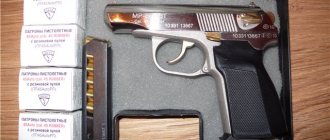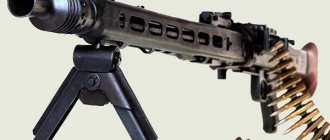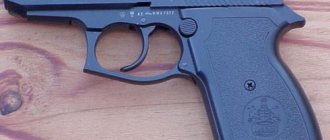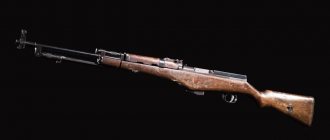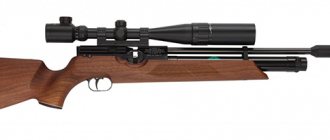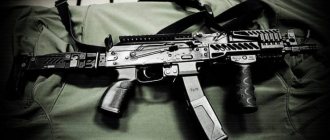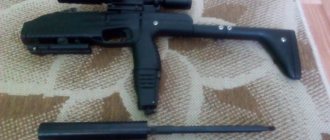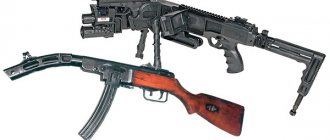Home | Weapons | Assault rifles | Russia / USSR | Kalashnikov assault rifle AK-74 / AKS-74
Kalashnikov AK-74 assault rifle
Kalashnikov AKS-74 assault rifle with folded stock
AK-74 with a GP-25 grenade launcher. Photo (c) KardeN
Automatic carbine AK-74 (GRAU Index - 6P20) 5.45 mm caliber, developed in 1970 by designer M.T. Kalashnikov, was adopted by the USSR armed forces in 1974. It is a further development of the AKM.
In the 1970s, following the NATO countries, the USSR followed the path of transferring small arms to low-impulse cartridges with reduced-caliber bullets to lighten the wearable ammunition (for 8 magazines, a 5.45 mm caliber cartridge saves 1.4 kg) and reduces , was considered to have “excessive” power of the 7.62 mm cartridge. In 1974, a weapon complex chambered for 5.45×39 mm was adopted, consisting of an AK-74 and an RPK-74 light machine gun, and subsequently (1979) supplemented by the small-sized AKS-74U, created for use in a niche that Western armies were occupied by submachine guns, and in recent years by the so-called PDW.
Main differences from its predecessor
- a new cartridge of 5.45×39 mm caliber (instead of 7.62×39 mm), which has a flatter bullet trajectory, which led to an increase in the direct shot range by 100 meters, and is also lighter (weight savings of 1.4 kg when carried ammunition in 8 magazines);
- a new muzzle brake-compensator, which serves to increase combat accuracy and reduce recoil energy;
- The magazine is made of light and durable plastic.
For assault rifles produced in 1974-1986, the butt and fore-end are made of wood. Since 1986, they began to be made from black plastic. Longitudinal grooves were made on the wooden butt on both sides to lighten the overall weight of the machine gun. They continue to be made on plastic stocks.
Can be used with the GP-25 or GP-30 or GP-34 underbarrel grenade launcher.
The accuracy of automatic fire has improved almost 2 times compared to the AKM (in linear dimensions). The accuracy of a single fire is approximately 50%.
The effective firing range of the AK 74 is:
For single ground and air targets - 500 meters;
For ground group targets - 1000 meters.
Direct shot range:
- According to the chest figure - 440 meters;
- His height is 625 meters.
Kalashnikov AK-12 assault rifle
Kalashnikov assault rifle AK-12 (2016 model) In mid-2011, on the initiative of NPO Izhmash, based on the Kalashnikov assault rifle, work began on creating a new assault rifle that meets the requirements for modern firearms and is designed to replace previous versions of the family of assault rifles Kalashnikov (AK and AKM, AK-74 and AK hundredth series lines). The development of the machine gun was carried out under the leadership of the chief designer of NPO Izhmash, Vladimir Viktorovich Zlobin.
At the end of 2011, assembly was completed and testing began on the first prototype of the 5th generation Kalashnikov assault rifle, and in January 2012, for the first time, a model of this weapon was demonstrated with the designation AK-12 (Kalashnikov assault rifle model 2012) chambered for 5.45x39 mm.
The AK-12 was a fundamentally new assault rifle, implemented using the general design and technical solutions of previous AK models. The main task in its creation was to improve the ergonomic characteristics of the weapon, increase its versatility, while maintaining and improving combat characteristics (reliability, service life, accuracy and shooting accuracy in different modes).
Kalashnikov AK-12 assault rifle (2012 model)
The Kalashnikov AK-12 assault rifle of the 2012 model used “classical” automatics with a long stroke of the gas piston and a rotating bolt. To improve ergonomic and operational characteristics, a number of changes have been applied, among which the following should be noted:
- by shifting the mass of the bolt group and reducing the recoil shoulder, the accuracy of fire is improved;
- a barrel with improved manufacturing accuracy characteristics was used;
- the rifling and bullet entry of the barrel were modified;
- the ability to quickly replace the barrel with a long or short version in the field;
- the ability to change the ejection side of spent cartridges during incomplete disassembly;
- a new design of the bolt group and trigger mechanism was used;
- double-sided pistol-type fire mode switch (for thumb) in 4 positions: safety and firing in three modes (single shots, two-shot cut-off and continuous bursts);
- installing the reloading handle on the gas piston rod and moving it to any side;
- immobility of the reloading handle during firing;
- shutter delay applied;
- two-way shutter stop button on the magazine release;
- a wide magazine release button in the access area of the index finger of the hand lying on the handle;
- built-in Picatinny rail on a rigidly fixed receiver cover for installing attachments (sights, rangefinders, flashlights);
- additional Picatinny rails on the bottom and sides of the forend, with the ability to install standard GP-25, GP-30 and GP-34 under-barrel grenade launchers;
- an open sight with an enlarged sighting line and a combined rear sight, allowing you to switch between slot and aperture (“diopter”) options;
- muzzle device of the machine gun, allowing the use of foreign-made rifle grenades;
- butt - folding telescopic with adjustable pad and butt plate;
- a mechanism for folding and fixing the butt, located in the butt itself and allowing the direction of folding to be set by simply turning the loop;
- the ability to use standard AK-74 and RPK-74 magazines, as well as promising 4-row box magazines with a capacity of 60 rounds.
The most noticeable was the improvement in ergonomics - complete symmetry of the machine gun, a convenient safety switch, and the introduction of a slide stop.
Kalashnikov AK-12 assault rifle (production model)
AK-12 with various additional accessories
In 2013, the 5.45-mm AK-12 assault rifle was proposed for a competition by the Russian Ministry of Defense as the main weapon of the promising “Ratnik” equipment. The Kovrov Mechanical Plant named after Degtyarev presented the A-545 model for this competition. As a result of the tests, it turned out that the Izhevsk AK-12 is significantly inferior in reliability to the Kovrov A-545.
In 2014, during state tests, despite a number of significant improvements, history repeated itself: the A-545 assault rifle, after modifications, was recommended for mass production and military testing, and the modification of the AK-12 was recommended at the expense of the developer. In addition, the unification of the AK-12 with the AK-74 models was no more than 10 percent, which meant that ultimately the creation and production of new weapons would cost 5-6 times more than the AK-74M.
In 2015, the AK-12 was completely recognized as not meeting the requirements of the tactical and technical specifications (TTZ). Izhmash itself had by that time been transformed into the Kalashnikov concern, and its management, which had completely changed, made a fundamental decision - to abandon further development of the AK-12, starting work on a project that received the original name “AK-400”.
Kalashnikov AK-12 assault rifle
The work on the AK-400 theme was headed by a new chief designer, Sergei Urzhumtsev. Under his leadership, through a deep modernization of the AK-74M, a new model was developed in a shock manner, incorporating the main and most successful proven design and technological solutions developed by Izhevsk developers.
Between 2015 and 2022, the updated AK-12 assault rifle passed all the necessary tests and was recommended for adoption.
In 2022, the Kalashnikov AK-12 assault rifle (GRAU index 6P70) was adopted by the Russian Federation and began to enter the Russian Armed Forces.
In terms of design, the AK-12 retained the gas-operated automatic system, traditional for Kalashnikov assault rifles, with the barrel bore being locked by turning the bolt.
The main parts and mechanisms of the AK-12 assault rifle: 1. Receiver with barrel, trigger mechanism, butt and handle, 2. Return mechanism, 3. Cover with rail and sight, 4. Bolt frame assembly, 5. Bolt assembly , 6. Trim, 7. Chamber plug, 8. Muzzle brake, 9. Forend assembly, 10. Forend axle, 11. Magazine, 12. Case assembly, 13. Accessory assembly
However, unlike its predecessors, it received a number of innovations:
- The bore and chamber are chrome plated;
- the forend is hung on the receiver and does not touch the barrel, the gas tube trim is rigidly attached to the forend and does not limit the vibrations of the barrel, protecting it from external loads;
- the gas tube has become non-removable, and the front plug is removed to clean it;
- The muzzle brake is installed on the bayonet instead of a thread and can be quickly replaced with a low-noise and flameless shooting device. The leading edge of the muzzle brake is a carbide bit that can be used to break glass or cut through wire fencing;
- To increase the rigidity of its fastening, the receiver cover is inserted at the rear into the grooves of the receiver and fixed with a transverse pin at the front;
- the receiver cover and forend are equipped with Picatinny rails, which form a single line on top, which ensures convenient installation of day and night sights of various types;
- on the bottom of the forend there is an additional Picatinny rail for installing accessories - a front handle, a flashlight, a laser pointer, etc.;
- mechanical sights with a diopter rear sight;
- The front sight of the open sight has been moved to the gas block, the aperture rear sight is mounted on a Picatinny rail as close to the butt as possible, and has the ability to introduce lateral corrections; installation of a slotted rear sight is possible;
- The fuse/fire mode switch has 4 positions (safety - AB (automatic fire) - 2 (burst 2 shots) - OD (single)), and also has an additional “shelf” for the index finger, which provides more convenient switching of fire modes without changing the grip shooting hand;
- The machine gun is equipped with a buttstock made of impact-resistant plastic that folds to the left and is adjustable in length (4 positions) with a height-adjustable butt plate;
- the pistol grip is made more ergonomic and equipped with a case in which you can place electric batteries for sights or medicine;
- there are no fastenings for the ramrod, which is made collapsible and moved to the butt case;
- standard magazines are equipped with transparent inserts, through which you can visually determine the number of cartridges; completely interchangeable with AK-74 magazines;
- under the barrel it is possible to install a bayonet or a 40-mm grenade launcher GP-25 or GP-34.
The buttstock is adjustable, folding on the left side;
Bayonet-type flash suppressor, with a device for knocking out locks; The rear sight is adjustable both vertically and horizontally; A pencil case with a collapsible cleaning rod is located in the butt; The oiler is located in the pistol grip. The level of unification of the new AK-12 with the basic model of the AK-74M was about 54 percent, and its production cost was only slightly higher than that of its predecessor. However, in comparison with the experimental AK-12, the production version abandoned the double-sided design of the machine gun, the bolt stop, the quick replacement of the barrel and a number of other solutions.
Based on the 5.45 mm AK-12 assault rifle, its AK-15 variant chambered for 7.62x39 cartridge, RPK-16 machine gun and AK TR3 civilian carbine were created.
AK-12 with low-noise and flameless shooting device
| Caliber, mm | 5.45x39 |
| Length, mm buttstock unfolded buttstock folded | 862-922 688 |
| Barrel length, mm | 415 |
| Width, mm | 72 |
| Height, mm | 270 |
| Weight without cartridges, kg | 3,5 |
| Store, count. cartridges | 30 |
| Direct shot range, m | 440 |
| Rate of fire, shots\min | 600-650 |
Normal combat requirements for AK74
- all four holes fit into a circle with a diameter of 15 cm at a distance of 100 m.
- the average point of impact deviates from the control point by no more than 5 cm in any direction.
Testing of combat is carried out by firing singles at a test target or a black rectangle 35 cm high and 25 cm wide, mounted on a white shield 1 m high and 0.5 m wide. Firing range - 100 m, position - lying down, without a bayonet, cartridges - with an ordinary bullet, scope - 3.
In general, one can note a significant improvement in the accuracy of fire compared to the AKM and especially the AK. As an example, consider the total median deviation at a distance of 800 m (vertical and width, respectively):
AK - 76 and 89 cm.
SKS - 47 and 34 cm.
AKM - 64 and 90 cm.
AK-74 - 48 and 64 cm.
AK-47 vs AK-74: how army “workhorses” perform (Business Insider, USA)
Also, when it comes to rifles, larger bullets often perform better in shorter barrels. Modern shooters have found that 7.62×39 bullets perform well in short barrels without losing speed or power as previously thought. The bullet still hits hard and provides excellent penetration from barrels up to 10 inches (25.4 cm) long. From a civics perspective, we need to look at uniformity and logistics in our AK-47 vs AK-74 death match. If you are in the United States and want a Kalashnikov, then the AK-47 will make more sense. Ammunition is cheaper and more common, as are magazines and variants of the AK 47.
Advantages of the AK-74
While the old guy still has plenty of power, the upstart we call AK-74 can take 47 to school in a few subjects.
When we talk about medium caliber automatic rifles, it is important to remember that size is not everything. In this AK-47 vs AK-74 shootout, we also have to consider ballistics. The lighter and smaller 5.45 cartridge tends to yaw and splinter when entering the case, while the 7.62 variant punches straight holes.
In addition, the AK-74 increases the effective firing range to 500 meters. A lighter cartridge also means lighter recoil. Lighter recoil means the weapon is easier to handle, especially in close combat. Not to mention, from a military perspective, the AK-74 provides more controlled automatic fire for suppression of opposition.
The ammunition is lighter, allowing soldiers to carry more of it. The AK-74 platform is becoming increasingly popular in the states, but still cannot match the popularity of the vintage 47.
So who wins?
It's time to announce the winner in the principle match "AK-47 vs AK-74". So who will it be? Classic 47 or young and bold 74? Well, that's not a simple answer.
If I were going to war and was asked to choose any of them, I would most likely choose the AK-74. I would like the extra range, improved handling, and lighter ammo.
If I were an ardent American small arms enthusiast, the AK-47 would be my choice because I like cylinder magazines, cheap ammo, and easy-to-find spare parts.
Variants of the Kalashnikov assault rifle
AK-74 is the main option.
AKS-74 (GRAU Index - 6P21) - a variant of the AK74 with a triangular metal butt folding to the side. Created for use in airborne troops (an assault rifle with a non-folding stock cannot be conveniently and safely placed in the parachute suspension system).
AK-74N is a “night” version of the AK-74 with a side rail for attaching night sights.
AKS-74N is a “night” version of the folding AKS-74, with a side rail for attaching night sights.
AK-74M - AK74 modernized.
Ammo used
- 7N6 (1974, bullet with a steel core, lead jacket and bimetallic jacket).
- 7N10 (1992, bullet with increased penetration, with a heat-strengthened core). Armor penetration - 16 mm from a distance of 100 m.
- 7U1 (subsonic bullet for silent shooting).
- 7N22 (1998, armor-piercing bullet with a core made of high-carbon steel U12A by cutting with subsequent grinding of the ogival part). Armor penetration - 5 mm from a distance of 250 m (grade 2P), 1.9 times better than 7N6.
- 7N24 (increased manufacturing precision, heat-strengthened tungsten carbide core)
A bullet with a steel core of a 5.45 mm cartridge when fired from an AK74 provides the following penetrating effect [source not specified 1165 days]:
Penetration with a probability of 50% of steel sheets of thickness:
- 2 mm at a distance of 950 m;
- 3 mm at a distance of 670 m;
- 5 mm at a distance of 350 m.
Penetration with a probability of 80-90% of a steel helmet at a distance of 800 meters;
Penetration with a probability of 75-100% of body armor at a distance of 550 meters;
Penetration of 50-60 cm into a parapet made of dense compacted snow at a distance of 400 meters;
Penetration of 20-25 cm into an earthen barrier made of compacted loamy soil at a distance of 400 meters;
Penetration with a probability of 50% of a wall made of dry pine beams with a cross-section of 20x20 cm at a distance of 650 meters;
Penetration of 10-12 cm into brickwork at a distance of 100 meters.
In 1986, new bullets were developed with a heat-strengthened core of increased hardness, providing a significant increase in penetration: the new bullet pierces a steel helmet at a distance of 960 meters, and body armor with titanium plates at a distance of 200 meters.
Another improvement of the bullet in 1992 again increased armor penetration (the army body armor Zh85-T penetrates at a range of 200 m, and the heavy Zh95-K at a range of 50 m) with a constant initial speed. The new cartridge, which is 1.84 times superior in armor penetration to the 7N6, received the index 7N10. 7N10 provides penetration of 16 mm at a distance of 100 meters.
Issue No. 57 Resource life of decommissioned quenched weapons
One of the questions that arises among potential buyers and owners of decommissioned weaponry is the question of the service life of the product. Or rather, about the number of light-sound cartridges that a particular model can fire before the first breakdown or complete failure.
It should be noted that this is not an idle question. The vast majority of decommissioned bleached weapons were made by converting them from military small arms, the design of which was irreversibly changed to prevent the use of the main parts (barrel, frame (receiver), bolt, drum) in similar military weapons. Such changes are called “deactivation” or, more simply, “fencing”.
In addition to the impossibility of using the main parts in combat, service, gas, OOOP weapons, many deactivated parts are also weakened in order to prevent not only the return of the lost destructive properties to the decommissioned weapon, but also to prevent the creation of homemade firearms with damaging properties based on its design.
Accordingly, even despite the seemingly lower loads when firing light-sound cartridges, the question of the service life of such weakened parts exists.
Take, for example, one of the most common models of cold weapons based on the Makarov pistol (PM). There are several of these (in chronological order of appearance on the market): PM-SO, VPO-525, Makarov-SO, PM-O. The first and third are “fenced” under the very weak 10 TK cartridge, the second and fourth are chambered for the more powerful 10x24. Except for the Makarov-SO, all other models have a weakened structure in the area of the trunnions along which the shutter moves. This nerf has two functions: the pistol bolt cannot be used on a combat pistol. Makarov-SO initially has a different geometry of trunnions on the frame and reciprocal grooves on the bolt, so it has no weakening as such.
The sound of a simulated shot is louder and richer in the VPO-525 and PM-O. However, these models (especially the VPO-525) account for the largest number of complaints, the essence of which are complaints about the play of the shutter on the frame increasing with the number of shots fired, which can ultimately result in separation (breakage) of the frame trunnion. Such damage cannot be repaired and the pistol in this form can only serve as a model.
Why does this happen? The physics of the process is very simple. To create the pressure necessary for the automation to operate, the channel of the barrel simulator is blocked by pins, which significantly reduce the throughput of the channel. In a military weapon, a bullet moves along the bore. During its movement, the gunpowder continues to burn, increasing the pressure and filling the space vacated (as a result of the movement of the bullet in the barrel bore). Unlike a bullet, the cross pin (or other choke) inside the simulator of the barrel of an immersed weapon does not move anywhere and does not free up any space. Only because of this, the sharpness of the free shutter rollback increases. It is worth remembering that in a firearm, the bullet will leave the barrel after a previously calculated time, which will lead to a sharp release of pressure in the barrel. In the case of a cooled weapon, the pressure of the powder gases is reduced to zero only when the cartridge case leaves the chamber (or at least reaches the point where the obturation of the cartridge case inside the chamber is noticeably reduced. As a result of this redistribution of the energy flows of the powder gases, most of them enter the weapon. Hot the gases burn out the lubricant and leave carbon deposits inside the weapon, which leads to increased wear of the rubbing pairs.
The above-described effect can be minimized by using gunpowders with other combustion parameters in light-sound cartridges. Most often this is gunpowder for smooth-bore weapons. Its distinctive feature is a sharp increase in pressure at the very beginning of combustion. This is why smoothbore shotgun barrels have massive chambers and the first 20 cm of the barrel. After this, the thickness of the walls of smoothbore shotgun barrels decreases sharply and can generally be only 1.5 mm. And this with a muzzle energy of over 3000 J!
In a cooled weapon, the charge of such gunpowder is less in mass than the charge of pistol gunpowder that also burns very quickly. As a result, when firing a light-sound cartridge, the pressure necessary to roll back the moving parts almost immediately develops. For a cooled weapon based on a PM charge, the porosity in the 10 TK cartridge is quite sufficient.
The 10x24 cartridge, which is more powerful due to the increased powder charge, develops pressure that is excessive for the system. As a result, the bolt receives a sharp impulse at the very beginning of the rollback, which neither the very powerful return spring nor the general inertia of the massive bolt can restrain. The shutter speed growth curve changes from gradually increasing to suddenly increasing to maximum. Rolling back from an excessively strong impulse during a shot, the bolt reaches its rearmost position, possessing an excessively large supply of kinetic energy. This results in a sharp impact of the bottom of the bolt against the protrusion of the trigger guard. Many people associate this blow with the recoil of the weapon, which is completely untrue. In fact, this impact provokes a redistribution of the shutter energy, which is expressed, among other things, in vertical vibrations of the shutter. And these vertical vibrations of the shutter are precisely the culprits for the breakdown of weakened frame trunnions. Let's be completely honest: with such a speed of recoil of the bolt of a combat PM, a breakdown would also occur. But only in the case of the PM, it would not be the trunnions on the frames that would fail, but the bolt would crack in the area of the so-called “beard”.
Is it possible to visually distinguish a cooled PM with such an excessively sharp shutter rollback? If at least one pack of light-sound cartridges was fired from the pistol, then a mark will appear on the back of the trigger from its impact with the frame during recoil. Such a mark on the combat PM usually indicates shrinkage of the standard return spring, which requires its replacement.
The appearance of such a mark is unlikely on Makarov-SO and PM-SO chambered for the 10 TK cartridge, which, although it does not have the “pseudo-recoil” effect, will noticeably extend the shooting life of a cold pistol.
Advantages
High reliability of operation in difficult conditions. Simplicity and low cost in production. In the AK-74M version - support for the installation of modern sighting and tactical devices, which is essentially a way to modernize the machine gun, and support for double-row box magazines similar to the Steyr AUG, made of impact-resistant plastic, with side inserts made of transparent polymer, for visual control of the amount of ammunition in the magazine .
Since one of the reasons for the creation of the AK-74 was a change in the caliber of the cartridge used by the machine gun, from 7.62x39 mm to 5.45x39 mm, the weapon has less recoil and, accordingly, greater shooting accuracy and a flatter bullet flight trajectory.
Flaws
Compared to the American M4A1 carbine, the AK-74 has lower single-fire accuracy.
In comparison with weapons with balanced automatics AEK-971, AK-107/AK-108, AK-74, the accuracy of firing bursts from unstable positions is 1.5-2 times lower.
The AK-74 lacks the ability to quickly change the barrel, like the FN SCAR, Steyr AUG, HK 416, and Bushmaster ACR; as well as a fixed-length burst firing mode, which was later added to the “hundredth series” assault rifles AK101-2, AK102-2, AK103-2, AK104-2, AK105-2.
The remaining advantages and disadvantages are similar to those for the entire AK family.
Small arms barrels
The barrel is the main part of a small weapon. The barrel of a rifled small arms is designed to impart rotational and translational motion to the bullet with a certain initial speed in a certain direction due to the energy of the powder charge. The rotational movement of the bullet, which provides it with gyroscopic stability in flight, is imparted so that it flies steadily with its head part forward and does not tip over under the influence of air resistance. The combination of barrel and cartridge determines the ballistic qualities of the weapon.
The design of the barrel is determined by the purpose of the weapon and the characteristics of its operation. The barrel as part of the weapon operates under special conditions. In order to withstand the high pressure of powder gases at high temperatures, the friction of a bullet as it moves in the barrel bore and various service loads, the barrel must have sufficient strength, which is ensured by the thickness of its walls and material and the ability to withstand high pressure of powder gases of 250 - 400 MPa ( up to 4,000 kg/sq.cm) at temperatures reaching up to 3,000 ºС. During combat use of a weapon, the barrel is subjected to various loads (during a bayonet strike, since the bayonet is usually attached directly to the barrel; during combat use of a weapon, including when fired from an under-barrel grenade launcher; when it falls, etc.). The outer outline of the barrel and the thickness of its walls are determined by the conditions of strength, cooling, the method of attaching the barrel to the receiver, the attachment of sighting devices, flash suppressors, muzzle brakes, as well as parts that protect against burns, handles, barrel linings, etc. to the barrel.
On the barrel there are breech, middle and muzzle parts. The muzzle (front) part of the barrel ends at the muzzle. The muzzle of the barrel is a cross section passing through the front end of the barrel without taking into account the flash suppressor (compensator, muzzle brake). The shape of the muzzle eliminates accidental damage to the rifling, which impairs shooting accuracy. The rear part of the barrel is called the breech, and its rear end is called the hemp of the barrel.
Inside the barrel has a through channel, which contains: a chamber that serves to place a cartridge; bullet entrance, which is a transitional section of the barrel channel from the chamber to the rifled part; and the threaded part. The bores of different types of weapons are approximately the same in design and differ only in the outline of the chamber, caliber and number of rifling. The chamber matches the shape and dimensions of the cartridge case, and its design is determined by the way the cartridge case is secured in it. The chamber must ensure free entry of the cartridge, good fixation of the cartridge case and obturation of the powder gases, as well as sufficiently free extraction of the cartridge case after the shot. On the other hand, the gap between the case and the walls of the chamber should be minimal, since too much gap can lead to rupture of the case.
To ensure tight fixation of the sleeve, the longitudinal dimensions of the chamber are selected accordingly, and the values of these dimensions are determined by the method of fixing the sleeve (along the rim, along the front slope), which, in turn, depends on the design of the latter.
Section of a Walter R.38 pistol in the chamber of the barrel of which the cartridge is fixed by the front cut of the cartridge case.
If the cartridge case has a protruding rim (flange), then fixation is usually carried out by resting this rim on the stump of the barrel. With this method of fixation, large errors are allowed in the longitudinal dimensions of the chamber and the sleeve itself. However, such cartridge cases usually complicate the cartridge feeding mechanisms and are now rarely used, although it is precisely for the domestic 7.62-mm rifle cartridge, which has a cartridge case with a protruding rim, that all heavy and single machine guns are designed: SGM, PK/PKM, PKB, PKT, as well as the SVD sniper rifle.
If the cartridge case has a non-protruding rim (waferless), then fixation is usually carried out by rolling the cartridge case into the chamber slope. In this case, there is a need for fairly accurate manufacturing of the chamber slope, which makes it necessary to increase the accuracy of manufacturing chambers and sleeves. Examples of this are the 7.62 mm wafer-type automatic cartridge mod. 1943 and the 5.45 mm 7N6 cartridge, used in Kalashnikov assault rifles and light machine guns.
For pistol cartridges, cartridge cases are most often secured by the front cut of the cartridge case neck. This fixation provides the simplest arrangement of the chamber in the presence of a cartridge case without a protruding rim, but for other types of cartridges it is unreliable. Therefore, it only applies to pistol cartridges that have cylindrical cases, for example, the 9 mm pistol cartridge for the PM pistol.
In most types of automatic weapons, the beginning of the extraction (extraction) of the cartridge case occurs during a period when the pressure of the powder gases in the barrel remains quite high. Good obturation of powder gases is achieved by a tight fit of the walls of the cartridge case to the walls of the chamber over a sufficiently long length. For this purpose, in cases where the cartridge case is displaced back at high pressure of powder gases (in systems with a free and semi-free shutter), sometimes a cylindrical surface is made in the rear of the chamber, which eliminates the breakthrough of powder gases even with large displacements back. Such a surface significantly reduces the jamming of the conical part of the cartridge case in the chamber after the shot and after the decline in the longitudinal deformations of the locking unit, since the areas of the bottom part of the cartridge case are usually subject to the greatest jamming. In some types of weapons, the frictional forces that arise between the case and the chamber can be so great that when the case is removed, it may rupture transversely or damage the rim by the ejector. To reduce these friction forces, Revelli grooves are sometimes used in chambers, which, by creating back pressure on a certain part of the outer surface of the cartridge case, facilitate its removal (extraction). Due to the complexity of manufacturing, rapid contamination and difficulties during cleaning, Revelli grooves are rarely used in modern weapons.
The bullet entrance connects the chamber to the rifled part of the bore and serves to accommodate the head of the bullet to ensure its smooth cutting into the barrel rifling. In rifled weapons, the bullet entrance consists of two cones, the first of which reduces the diameter of the chamber to the diameter of the rifling fields. The second cone serves to ensure gradual penetration of the bullet into the rifling (this cone is absent in smooth-bore weapons). The accuracy of the weapon's engagement largely depends on the size and shape of the bullet entrance. The length of the bullet entry ranges from 1 to 3 gauges.
Caliber is a unit of measurement used in weapons to measure the internal diameter of the bore and the external diameter of the bullet. The caliber of a rifled barrel is defined as the distance either between two opposite fields of the barrel, or between two opposite rifling. In Russia, the caliber of a barrel is measured by the distance between two fields. In this case, the caliber of the bullets in relation to the weapon exceeds the caliber of the barrel in order to ensure that the bullet cuts into the rifling so that the bullet acquires rotational motion. Thus, the barrel diameter of the Makarov PM pistol along the rifling fields is 9 mm, and the bullet diameter is 9.2 mm. The caliber of a weapon's barrel is indicated in the system of measures adopted in the country of manufacture of the weapon. In countries with a metric system of measures, symbols are used in millimeters, and in countries with an inch system of measures, in fractions of an inch. So, in the USA the caliber is indicated in hundredths, and in the UK - in thousandths. In this case, the caliber is written as an integer with a dot in front, for example, the American pistol Colt M 1911 A1 .45 caliber.
Different armies have adopted different forms of rifling. In the Soviet Union/Russia, the rifling shape was rectangular in cross-section, with the rifling depth being 1.5 - 2% of the weapon's caliber. The remaining rifling profiles are used in various foreign models, for example, the trapezoidal profile is used in the Austrian 8-mm Mannlicher M 95 repeating rifle; segmented profile - in Japanese 6.5 mm Arisaka type 38 repeating rifles; oval profile - by Lancaster; beveled profile - in the French 7.5-mm machine guns Chatellerault M 1924.
The direction of the rifling in the barrel can be right (in domestic models) or left (in England, France). Different directions of rifling do not have any advantages. Depending on the direction of the rifling, only the direction of derivation (lateral deflection) of the rotating bullet changes. In domestic small arms, the right direction of rifling is accepted - from left to top to right as you move along the bore from the breech to the muzzle. The angle of inclination imparted by the rifling ensures the rotational movement of the bullet, while its stability in flight depends on the speed of rotation of the bullet. The length of the rifling stroke (the length of the barrel bore at which the rifling makes a full revolution) also has a significant impact on the accuracy of fire. The rifling pitch of the AKM assault rifle is 240 mm, the DShKM machine gun is 381 mm, and the KPV machine gun is 420 mm.
The length of the rifled part of the barrel of each weapon sample is selected from the condition of obtaining the required initial bullet velocity. The use of the same cartridge in weapons with different barrel lengths makes it possible to obtain different initial bullet speeds (See Table 1).
| Weapon name | Chuck type | Length of the rifled part of the barrel, mm | Initial bullet speed, m/s | Direct shot range, m |
| Pistol PM | 9mm cartridge | 75 | 315 | 50 |
| APS pistol | 9mm cartridge | 122 | 340 | 200 |
| Automatic AKM arr. 1943 | 7.62 mm cartridge | 369 | 715 | 350 |
| RPK machine gun mod. 1943 | 7.62 mm cartridge | 544 | 745 | 365 |
| RPD machine gun mod. 1943 | 7.62 mm cartridge | 475 | 735 | 365 |
| AK-74 7N6 assault rifle | 5.45 mm cartridge | 369 | 900 | 625 |
| Machine gun RPK-74 7N6 | 5.45 mm cartridge | 544 | 900 | 640 |
| PC machine gun | 7.62 mm cartridge | 550 | 825 | 420 |
| PKT machine gun | 7.62 mm cartridge | 667 | 825 | 420 |
The table shows that the range of a direct shot increases with increasing initial speed for the same cartridge, which affects the improvement of the flatness of the trajectory and an increase in the affected space. As the initial speed increases, the effectiveness of the bullet on the target increases due to the greater energy of the bullet. So, at a distance of 1000 m, a bullet fired from the barrel of a PK machine gun has an energy of 43 kgf/m, and a bullet fired from the barrel of a machine gun has an energy of 46 kgf/m.
In shotgun hunting weapons, the guide part of the bore is smooth (without rifling), and its muzzle can be narrowed (conical or parabolic) or widened. The narrowing of the canal is called choke. Depending on the magnitude of the narrowing, which improves the accuracy of shooting, they are distinguished as half choke, medium choke, choke, and strong choke. A flare at the muzzle, called a bell, increases shot dispersion and can be conical or other shaped.
Barrels in small arms are structurally distinguished into barrels - monoblocks and bonded barrels. Barrels made from a solid metal billet are called monoblock barrels. However, to increase the strength of the barrel, they are made of two or more pipes, pressed onto one another. Such a trunk is called bonded. Bonding barrels has not been widely used in automatic weapons due to the complexity of manufacturing. The connection of the barrel to the receiver with interference can be considered as a partial fastening.
Rational cooling of barrels for modern automatic weapons is of extremely great importance. The leading parts of the bullet, cutting into the rifling, receive significant plastic deformations and thus exert additional pressure on the walls of the barrel bore. Wear of the bore is caused by friction against the surface of the bullet shell, which moves with a large friction force at high speed. Moving after the bullet, as well as partially breaking through the gaps between the walls of the barrel and the bullet, the gases produce intense thermal, chemical and erosive effects on the barrel bore, causing its wear. Rapid abrasion of the surface of the barrel bore leads to the loss of some properties necessary to ensure firing efficiency (the dispersion of bullets and shells increases, flight stability is lost, and the initial speed decreases below a given limit).
When the barrel is heated strongly, its mechanical qualities decrease; the resistance of the barrel walls to the action of the shot decreases; this leads to increased metal wear and reduced barrel survivability. When the barrel is very hot due to the appearance of rising air currents, aiming becomes difficult. The high temperature of the breech of the barrel can lead to the fact that a cartridge, chambered after the shooting has stopped, can heat up to the point of self-ignition, which makes handling the weapon unsafe. In addition, the high heating of the barrel makes it difficult to operate the weapon. To prevent shooters from suffering from burns, special shields, handles, etc. are mounted on the weapon.
The high temperature of the powder gases causes rapid heating of the barrels of automatic weapons during firing. It follows that the intensity of the barrel heating depends on the power of each shot and the fire mode. For weapons intended for single-shot shooting with low-power cartridges (pistols), barrel cooling is of secondary importance. For weapons that fire powerful cartridges (machine guns), the cooling should be more effective, the larger the magazine (belt) capacity and the longer the continuous shooting should be carried out from this type of weapon. An increase in barrel temperature above a certain limit reduces its strength characteristics and service life. All this ultimately limits the fire mode (i.e., the permissible number of shots during continuous firing).
Special methods for barrel cooling include: quick replacement of a heated barrel with a cooled barrel; increasing the barrel cooling surface due to ribs; the use of various types of attachments (radiators) for the same purpose; artificial blowing of the outer or inner surface of the trunk; the use of liquid coolants, etc. Currently, two types of barrel cooling are most widely used - air and water.
Air cooling has become the most widespread among modern weapons due to its simplicity, but it does not provide a high intensity of heat transfer into the air.
To increase the heat transfer of the barrel, its surface is usually increased using special transverse or longitudinal ribs. The effectiveness of this method is determined by the size and number of trunk ribs. The use of ribs on the outer surface of the barrel, although it increases the total area of heat exchange with air, leads to uneven heating of the barrel metal and ultimately reduces its overall heat capacity. However, increasing the ribs of the trunk leads to its weighting, which is unprofitable. There are known attempts to use ribs made of light alloys put on the barrel. However, this method has not become widespread due to the complexity of manufacturing such barrels. To increase heat transfer, devices were designed that improved air circulation by blowing through the barrel bore and blowing on its outer surface. For example, in the English Lewis M 1914 light machine gun, a radiator with longitudinal ribs made of light alloy was put on the barrel, and a casing in the form of a pipe was put on the radiator. During firing, the jet of powder gases emerging from the barrel formed a vacuum in the front part of the casing, as a result of which air was sucked into the casing at the back and passed between the ribs, increasing the intensity of their cooling. The use of such a design increased the intensity of barrel cooling during firing, but it was found that during breaks between bursts, the casing prevented the flow of fresh air, which ultimately did not lead to improved barrel cooling.
Section of a Colt M 1911 A1 pistol, where the barrel, which is separated during disassembly, is attached to the frame using an earring.
Currently, modern models of automatic weapons with air-cooled barrels (heavy machine guns) often do not have ribs on the barrel or they are made very small, using fairly massive barrels, for example, in the Austrian 5.56 mm AUG assault rifle, a screw thread is simply knurled on the barrel in increments of approximately 1 mm. For light weapons (machine guns and light machine guns), either the fire mode is limited, or (for light and heavy machine guns) quick-change barrels are used, which make it possible in a combat situation to quickly replace the heated barrel and thereby ensure a high fire rate. At the same time, automatic weapon barrels, as a rule, have large safety margins. A thicker barrel, having a greater thermal capacity, heats up less from shot to shot, which increases the duration of continuous fire until the barrel reaches dangerous overheating and increases its service life. In this regard, barrels chambered for the same cartridge in weapons intended for use in harsh fire conditions (for example, single PK/PKM machine guns) have a thicker barrel than in weapons that have a relatively low practical rate of fire (SVD rifle).
Particularly effective is water cooling of barrels, which was widely used in heavy machine guns in the past. Its feature is a sharp decrease in barrel temperature during minor breaks in shooting due to intense heat transfer from the barrel to the coolant. To cool the barrel of a normal-caliber machine gun, it is enough to have a water supply in the casing of about 3-4 liters, and for a heavy-caliber machine gun 5-8 liters. This cooling system allows for continuous fire until all the water has boiled away. However, the presence of a casing with water greatly complicates the design of the weapon and its operation, and also increases the vulnerability of the weapon itself in battle. An example is the domestic 7.62-mm Maxim machine gun mod. 1910. In addition, water cooling of the barrel also has a number of disadvantages: a constant supply of water is required; at low temperatures, water freezes, which can damage the casing and barrel; the weight of the weapon increases to the detriment of maneuverability; difficulty in preparing weapons for firing; high vulnerability of weapons in battle, etc.
Due to these disadvantages, water cooling of barrels is not used in modern small arms, but is successfully used in stationary automatic weapons, for example, in ship installations.
There are two main types of fastening the barrel to the receiver: a detachable connection of the barrels with the receivers of the weapon, which provides for a quick change of the barrel without disassembling the weapon, and a one-piece connection, which does not.
In most modern small arms, the service life of which is the same as that of the barrel (SVD rifles, AKM/AK-74 assault rifles, RPD/RPK/RPK-74 light machine guns and PM pistols), which do not have a device for quickly changing barrels, The barrel is connected to the receiver by a permanent connection. This can be a threaded connection with an interference fit, as, for example, in the Dragunov self-loading rifle, or a mating of a cylindrical surface with an additional pin fastening. In this case, the assembly of barrels with receivers is carried out in the factory.
Fastening of barrels that separate during disassembly can be done using a bayonet and threaded connection, an earring or a pin. The last two types are used in some pistols, providing ease of disassembly and cleaning. An example is the barrel mount for a Tokarev TT pistol. In addition, detachable connections between barrels and receivers (which do not provide quick replacement of barrels) are usually used in machine guns, single and large-caliber machine guns PK, KPV, DShKM, NSV and their modifications. Detachable connections allow you to replace heated barrels with spare ones during the operation of the weapon and thereby make it possible to conduct intense and prolonged fire (while one barrel is being fired, the other is cooling). In addition, the presence of a replaceable barrel increases the survivability of the weapon.
Detachable connections of quick-change barrels with receivers are usually made with crackers or wedges. These connections are used mainly for light and heavy machine guns. Suspension-threaded connections are most often made with screws, for example, in the 12.7-mm machine gun DShK mod. 1938. Sometimes the barrel turns when connected, and sometimes a special coupling turns. In some cases, the barrel is simply inserted with its cracked protrusions into the corresponding grooves of the receiver. In systems with a movable barrel, special protrusions on the barrel are sometimes used to attach barrels to receivers (spikes in the Maxim heavy machine gun model 1910). In addition, the replaceable barrel is also connected to the receiver using a wedge connection. Thus, in the DShKM machine gun, the barrel is connected to the receiver using a wedge. Despite the simplicity of the design, such a connection is inconvenient to use, since to replace the barrel it is necessary to unscrew the nut and knock out the wedge. A more advanced design of this type is used in the NSV heavy machine gun. In systems with a fixed barrel - PK/PKM, SGM machine guns and their modifications - an adjustable wedge is used to compensate for the wear of the bolt lugs. By adjusting the distance between the bottom of the bolt cup and the breech end of the barrel (mirror gap), complete locking of the bolt is ensured and the occurrence of a delay in the form of a transverse rupture of the cartridge case during firing is eliminated. In order to facilitate the separation of the barrel from the receiver in a heated state, the outer surface of the breech of the PKM/PKT machine gun barrels is chrome-plated.
Spare barrel with case for a single MG.42 machine gun
Devices for various purposes can be attached to the muzzle of the barrel. Thus, on the barrel of AKM assault rifles manufactured in 1959 - 1962, a coupling is installed to protect the thread from damage, and on the barrel of AKM assault rifles manufactured in 1963 - 1975, a compensator is attached to increase the accuracy of combat when firing in bursts on the move, standing and kneeling. The compensator has a threaded part that serves to connect to the muzzle of the barrel. The front part of the compensator is made in the form of a protrusion with an oblique cut. A groove is made inside the protrusion, forming a compensation chamber. Powder gases, after leaving the barrel bore, create excess pressure, which deflects the muzzle of the barrel towards the protrusion (down to the left). The AK-74 assault rifle uses a two-chamber muzzle brake-compensator, which simultaneously acts as a flame arrester, which significantly increased the stability of the weapon when firing. On the barrels of the RPK, PK/PKM machine guns, the SVD sniper rifle and the AKM assault rifle, which have a mount for a night sight, slotted flame arresters are attached, designed to reduce the intensity of the glow of powder gases heated to a high temperature and the burning powder particles as they exit the barrel. Reducing the visibility of the muzzle flame is achieved by the fact that most of it is covered by the side walls of the flame arrester. PKT, SGM, KPVT, NSV machine guns have flame arresters with a conical socket. In this flame arrester, due to the influx of ambient air into it, intense combustion of the powder particles is ensured, thereby reducing the brightness of the muzzle flame when firing.
The flame arrester of the KPVT machine gun has a more complex design, consisting of the flash suppressor itself, the base of the muzzle, the bushing and the barrel piston. In this regard, the flame arrester of the KPVT machine gun, in addition to reducing the brightness of the muzzle flame, provides an increase in the recoil energy of the movable barrel.
Muzzle brakes can also be installed on the barrels, designed to reduce the recoil energy of the barrel by removing part of the powder gases in the lateral directions and reducing its outflow in the axial direction.
Gas exhaust devices are attached to the barrels of weapons that operate on the principle of using the energy of part of the powder gases discharged through a side hole in the barrel wall. These devices have a narrow inlet part connected to the barrel bore and a widened outlet part - the gas chamber. Gas regulators are installed in the gas chambers of the PK/PKT, SGM, RPD, SVD barrels, ensuring the reliability of the automation in various operating conditions. This is achieved by changing the amount of powder gases acting on the bolt frame piston.
There are the following ways to regulate the intensity of the action of gases on the bolt frame piston: - changing the area of the minimum cross-section of the gas pipeline through which gases flow from the barrel into the gas chamber of machine guns (PKT, SGMT). This design of the gas regulator makes it possible to reduce gas pollution inside the tank combat vehicle; — release of gases from the chamber into the atmosphere (SVD rifle, PK/PKM machine gun). The maximum speed of the bolt frame will be when the holes are closed, since in this case the maximum amount of gases will be supplied to the bolt frame piston.
Sergey Monetchikov Photo from the author’s archive
Technical characteristics of AKS-74
- Caliber: 5.45×39
- Weapon length: 940/700 mm
- Barrel length: 415 mm
- Weight without cartridges: 3.4 kg.
- Rate of fire: 600 rounds/min
- Magazine capacity: 30 rounds
Assault rifles
- Austria
- Brazil
- Czech
- South Korea
- South Africa
- France
- USA
- Singapore
- Spain
- Russia/USSR
- Australia
- Finland
- Germany
- Türkiye
- Switzerland
- Denmark
- Japan
- Israel
- Sweden
- Indonesia
- Belgium
- Poland
- Ukraine
- Italy
- Croatia
- Iran
- Dominican Republic
- Mexico
- Serbia
- Argentina
- China
- Canada
- Taiwan
- Great Britain

